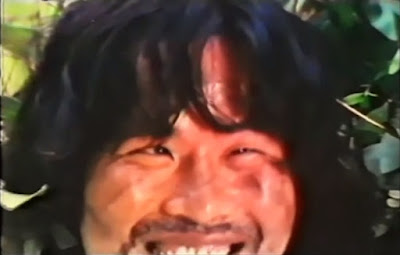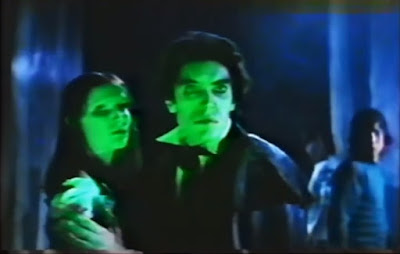... aka: Gate of Hell, The
... aka: Gate of the Hell, The
... aka: Gui yu
... aka: Vampire Domain
Directed by:
Pao-Lun Lu
Quite a peculiar film we have here! Made for the apparently one-shot Hong Kong production company Yee Lung Film Company, this has a contemporary setting (not so common with 1970s and early 80s HK horror films), a number of Caucasian actors playing lead roles, Chinese actors given very English-sounding character names and a "camping in the woods" type scenario filled with clichés more fitting North American films of this time. Though a practice far more common with martial arts movies, this is also a rare older Hong Kong horror movie that's been English dubbed. Both British and American actors are used so accents vary. There are also English subtitles added despite the English dubbing so you get two times the English translations here. Several of the guys wear American-style shirts (one wears a Dallas Cowboys jersey and another wears one that just says "Football" on it) and the characters all behave rather like dumb U. S. slasher flick teens. That makes me suspect this is a misbegotten attempt to appeal to viewers outside of Asia to make this some kind of international crossover release. Seeing how I could find no U. S. poster for this film nor any evidence it was ever actually released here, I'd say that was a failed attempt.
Thanks to their professor filling their heads with tall tales about the area, eight college students consisting of four guys - Kenny (Tao-Hung Li), David (Lieh Wei), Robert (Chu-Sek Luk) and Michael, and four girls - Kitty (Violet Lee Ying), Lucy (Yeung-Yeung Lam), Helen and Mary, arrive in the woods to go camping near the Devil's Hill area. After running afoul of a cross-eyed halfwit woodcutter (Tan Wan Yue) who tries to warn them about the area and mooches some food off of them, they build a fire for the night and then can't decide what to do. After passing on leapfrog, they put on monster masks and have a dance party instead. Lucy even treats the guys to a little strip tease action that seems to have been completely removed from the version I watched. After retiring for the night, Kenny and Kitty are awakened by a raging storm with high winds that blows their tents over. However, when they look for their friends, they've all vanished.
The couple make their way through the woods and stumble upon a vacant and decrepit old mansion that has a cross fastened to the door. The two enter, make a fire and plan on staying there for the night. Down in the cellar, blood from a dead animal drips into a coffin and right into the eye socket of a skull, which then time lapses into a white (well, actually usually green), European-style vampire. He's played by "Warrick Evens" / Warwick Paul Evans, a British guy who also worked as an anchor for the English-language Pearl News out of Hong Kong. Kitty and Kenny are awakened by the sounds of the revived vampire banging on his coffin lid, go down into the cellar to investigate and are attacked by a snake (!) During the struggle, the cross holding the vamp inside gets knocked off.
The vampire emerges from his coffin, announces himself as "The Master" (he's never once called Dracula in the English version despite what some sources state) and tells the trespassers they must now stay in the home and be his servants. However, he also agrees to let them go if they'll do one little thing for him instead: Open a door, go inside and then remove crosses from a bunch of other coffins. However, realizing they'll only release a slew of other vampires in the process, they remove one and use it to drive him away, releasing one of the vampire's brides ("Ema Emily" / Emma Amelie) in the process.
After Kenny is bitten and transformed into a vampire, and Kitty discovers all of the rest of their missing friends have also been turned into bloodsuckers, she's forced into a game of "try to survive the night" in the large, dark mansion all by herself. That requires her to run around, go up and down stairs, explore different rooms, make a leap off the second story of the building, scale a tall wall that surrounds the property, try to find hiding places and try not to make a creak as she's doing all of that as the slew of vampire scour the grounds looking for her. These scenes are definitely the highlight of the film and are suspenseful and even fairly intense at times. They also reminded me a lot of the later NIGHT OF THE DEMONS (1988).
It was a good idea to bring European-style vampires, their accompanying mythology and Gothic gloom to Hong Kong as a change of pace, kind of like Michio Yamamoto did with his "Bloodthirsty Trilogy" in Japan, but this film is in desperate need of rescue and repair, if that's even possible at this point. To get much enjoyment out of it in its current state requires one to almost completely disregard all of the dialogue, which has been ruined by the dubbers. Not only are most of the voice actors bad but the lines themselves ("How come the vampire doesn't speak in Transylvanian?") are God awful. The film is further harmed by the terrible quality of the only available print currently floating around. It's dark, blurry, appears to have been cut (it's just 74 minutes long) and is filled with tape damage.
That said, I was able to push those major flaws aside and ended up quite enjoying this. While the make-up is pretty crappy, it has good art direction (well, what we can make out through the dark print), plenty of dreary atmosphere, colorful lighting and some genuine surprises. I wasn't sure where this was really going for the longest time but once it settled down to the final girl character having to rely on her own wits to survive in a house of horrors filled with people out to get her it turned out to be quite enjoyable. There's even a long final scene at a hospital where Kitty has to deal with a detective (Wah-Lung Szema) who doesn't believe her story while being helped by a priest (Bill Lake). The vampires eventually show up there too trying to get her. Didn't much care for the final twist, though, simply because it's so overused.
Depending on where you look, release years for this title are either 1977 (per Hong Kong Movie Database), 1978 (per Letterboxd) or 1981 (per IMDb), so let's clear that up right now. Confirmed by the star himself, this was filmed back in April and May of 1977 but didn't receive a release until 1981. The star also stated in an interview that it took so long to release because this was an independent production made far away from the major Hong Kong studios (who typically hogged up all of the theater space) and it didn't fit the standard formula of other genre films being released there at the time so most theaters didn't want to screen it.
As far as home video releases are concerned, I could only find one: An ancient Betamax release from Pan Video out of Indonesia. This is very likely the source of the print I happened to view. The on-screen English title is "The Gate of the Hell," which is probably supposed to be "The Gate of Hell" but, grammar be damned, I'm still going to file it here under the title "The Gate of the Hell" to help differentiate it from several other movies using the exact same (or a very similar) title. The director only made one other film to my knowledge: the Kent Cheng vehicle THE ACCIDENT (1983).
★★1/2
























































